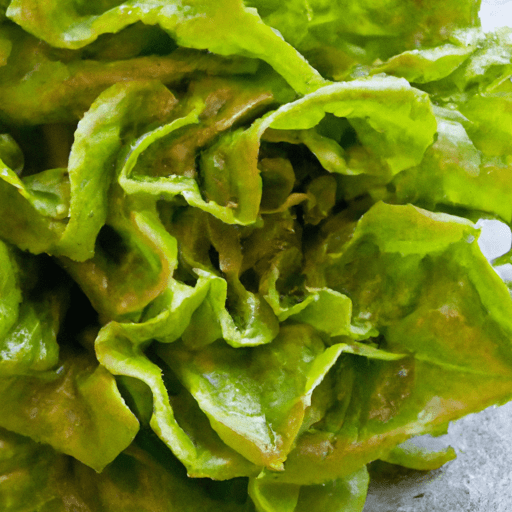Butterhead Lettuce: Delicate, Nutritious, and Versatile
Butterhead lettuce is a popular leafy green that offers a delicate flavor and a satisfying crunch. With its soft, buttery leaves and mild taste, butterhead lettuce consistently wins over the hearts and palates of food enthusiasts. In this article, we will explore the cooking-related aspects of butterhead lettuce, including its taste profile, common uses in cooking, nutritional value, and some interesting history and facts.
Taste Profile and Characteristics
Butterhead lettuce, as the name suggests, is known for its smooth, buttery texture and mild flavor. The leaves are tender and slightly sweet, making it a delightful addition to salads and sandwiches. Its velvety softness provides a pleasant chewing experience, while its subtle taste allows the other ingredients in a dish to shine.
Common Uses in Cooking
Due to its delicate nature, butterhead lettuce is primarily used in raw preparations, especially in salads. Its soft leaves create the perfect base for vibrant, refreshing salads that burst with flavors. When mixed with other greens like arugula, spinach, or romaine, butterhead lettuce adds a pleasant contrast in texture and flavor.
Beyond salads, butterhead lettuce is also often used as a topping in sandwiches, burgers, and tacos. Its crisp yet tender leaves provide an excellent crunch, while its mild taste complements a wide range of ingredients. For those looking to get creative, butterhead lettuce can even be used as a wrap for various fillings, replacing traditional tortillas or bread.
Nutritional Value
Butterhead lettuce, like many other leafy greens, is packed with essential nutrients. It is an excellent source of vitamins A and K, which play crucial roles in maintaining healthy vision, promoting bone health, and supporting a strong immune system. Additionally, butterhead lettuce contains small amounts of vitamins C, E, and B vitamins.
Low in calories and carbohydrates, butterhead lettuce is a great choice for those who are watching their calorie intake or following a low-carb diet. Its high water content also contributes to hydration, making it a refreshing option during hot summer months.
History and Fun Facts
Believed to have originated in the Mediterranean region, butterhead lettuce has a rich history dating back thousands of years. It was a favorite among Egyptian pharaohs, who enjoyed its tender leaves and mild flavor. Throughout history, butterhead lettuce gained popularity across Europe, eventually making its way to North America during the 17th century.
Butterhead lettuce is commonly associated with the classic French salad known as “Salade au Beurre” or “Butter Salad.” This salad traditionally includes butterhead lettuce leaves tossed in a vinaigrette dressing, garnished with fresh herbs, and sometimes topped with croutons or cheese. Its simplicity allows the lettuce’s subtle flavors to shine.
Interesting to note, butterhead lettuce is also known by other names, such as bibb lettuce (after a 19th-century horticulturist), Boston lettuce (popularized in the Boston market), and limestone lettuce (as it grows successfully in alkaline soil).
Conclusion
Butterhead lettuce offers a remarkable combination of textures, flavors, and versatility in the world of leafy greens. With its delicate, buttery leaves, it adds a touch of elegance to salads, sandwiches, and various other dishes. Beyond its satisfying taste, butterhead lettuce brings a wealth of nutritional benefits to the table. So, the next time you’re looking to elevate your salad game or create a delicious, light wrap, consider reaching for butterhead lettuce and let its subtle charm impress you.
Sure! Here are some interesting facts about butterhead lettuce:
Origin and History
- Butterhead lettuce, also known as Boston or Bibb lettuce, is believed to have originated in the Mediterranean region.
- The lettuce variety gets its name from its soft and buttery texture, similar to that of butter.
- The cultivation of butterhead lettuce is traced back to ancient Egypt, where it was a prized vegetable.
Common Uses
- Butterhead lettuce is often used in salads and sandwiches due to its tender leaves and mild flavor.
- Its delicate nature makes it a popular choice for lettuce wraps or as a base for various fillings and toppings.
- Its crispness and high water content make it a refreshing addition to summer salads.
Nutritional Benefits
- Butterhead lettuce is a low-calorie vegetable, as it contains approximately 13 calories per 100 grams.
- It is an excellent source of vitamins A and K, providing a significant portion of the recommended daily intake.
- This lettuce variety is also a good source of folate, iron, and dietary fiber, contributing to a balanced diet.
Unique Properties
- Unlike other lettuce varieties, butterhead lettuce forms a looser head of leaves, allowing for easier harvesting and preparation.
- The leaves of butterhead lettuce are typically softer and more tender compared to other lettuce types.
- Its mild flavor pairs well with a variety of dressings, herbs, and other ingredients.
Remember to wash and dry butterhead lettuce thoroughly before consuming to remove any lingering dirt or debris.




Use the share button below if you liked it.
It makes me smile, when I see it.